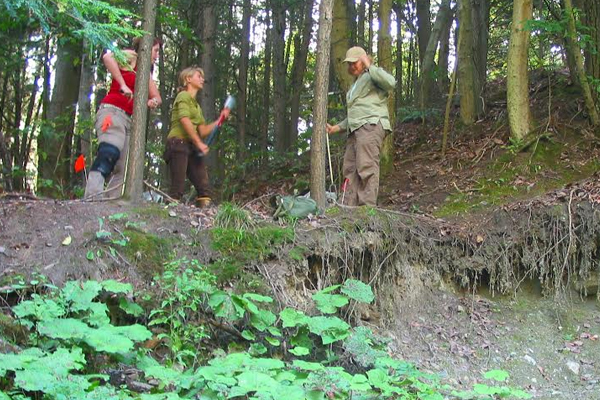Not All Forms of Stream Bank Phosphorus Lead to Algal Blooms
Dec. 21st 2015Miles of soil lie perched on the banks of Lake Champlain’s tributaries – waiting to be pushed downstream by natural or anthropogenic forces. These tributaries reach into the surrounding watershed through a mosaic of agricultural fields, forestland, wetland, and development. However, it is not just soil that can be released from the landscape. A number of elements and associated compounds are transported as well, bringing with them potential implications for the downstream ecosystems. Phosphorus, which can lead to increased algal blooms, is at the forefront of current research and discussion surrounding the state of the lake.
To shed light on this issue, a recent study from the University of Vermont investigated which streams have the greatest potential to contribute phosphorus. Furthermore, the study addressed whether the released phosphorus would be in a form that further exacerbates algae blooms in Lake Champlain. Given the shear extent of the basin – over 4,600 sq. miles in Vermont alone – the task of quantifying phosphorus resulting from non-point sources is daunting. Compounding this problem is the fact that not all streams are created equal – nor are the components that line their banks.
Recent UVM M.S. students Eulaila Ishee, from the Plant and Soil Science Department, and Kerrie Garvey, from the Rubenstein School, under the advisement of Dr. Don Ross and Leslie Morrissey, chose four streams within Chittenden County to focus their sampling efforts. They randomly sampled 76 erosion sites along the LaPlatte River, Indian Brook, Alder Brook, and Allen Brook to get an idea of the associated soil’s physical and chemical make-up.
Not only was the research group interested in total phosphorus – a commonly used metric in water quality studies – but also the amount of potential bioavailable phosphorus measured in degree of phosphorus saturation (DPS). The researchers determined that “although the relationship between DPS and P release may vary among soil types, the low DPS we found in most of our samples suggests that, on erosion, these soils would likely be short-term sinks for inorganic P and not sources”. Therefore, the type of phosphorus leading to algae blooms in the lake may remain upstream along banks in the short term, at least in Vermont’s most populous county. The study also found consistent measures of total phosphorus across sample sites, which could be used as a suitable estimate for the remaining extent of the watersheds.
The researchers then related the soil data collected in the field to remotely sensed data, including aerial photography, LIDAR, mapped soil surveys, and land use classifications. Significant correlations between measured data and landscape characteristics can help establishing predictors of total phosphorus within similar watersheds. Additionally, the researchers were able to estimate erosion rates based on this spatial data. They found that the portion of total non-point phosphorus export potentially contributed by streambank erosion ranged from 6% (associated with the lowest erosion rates) and 30% (associated with the highest erosion rates).
However, the story surrounding phosphorus – and non-point sources within the Lake Champlain Basin – is far from over. Continued research throughout other regions of the basin will help tell a more complete story, which will inform policy and land management decisions. Additionally, a distinction between total phosphorus and bioavailable forms will drive research that more appropriately addresses the issue of algal blooms in Lake Champlain. Researcher Don Ross states that the trends witnessed for Chittenden County may not be the same for the rest of the lake basin. "Since this study, we've sampled streambanks in the Missisquoi Watershed and along the Mad River as part of the ongoing VT EPSCoR RACC project. We've found some locations where there appears to be elevated phosphorus and likely a greater potential for these eroding banks to deliver bioavailable P".
 ecoNEWS VT
ecoNEWS VT